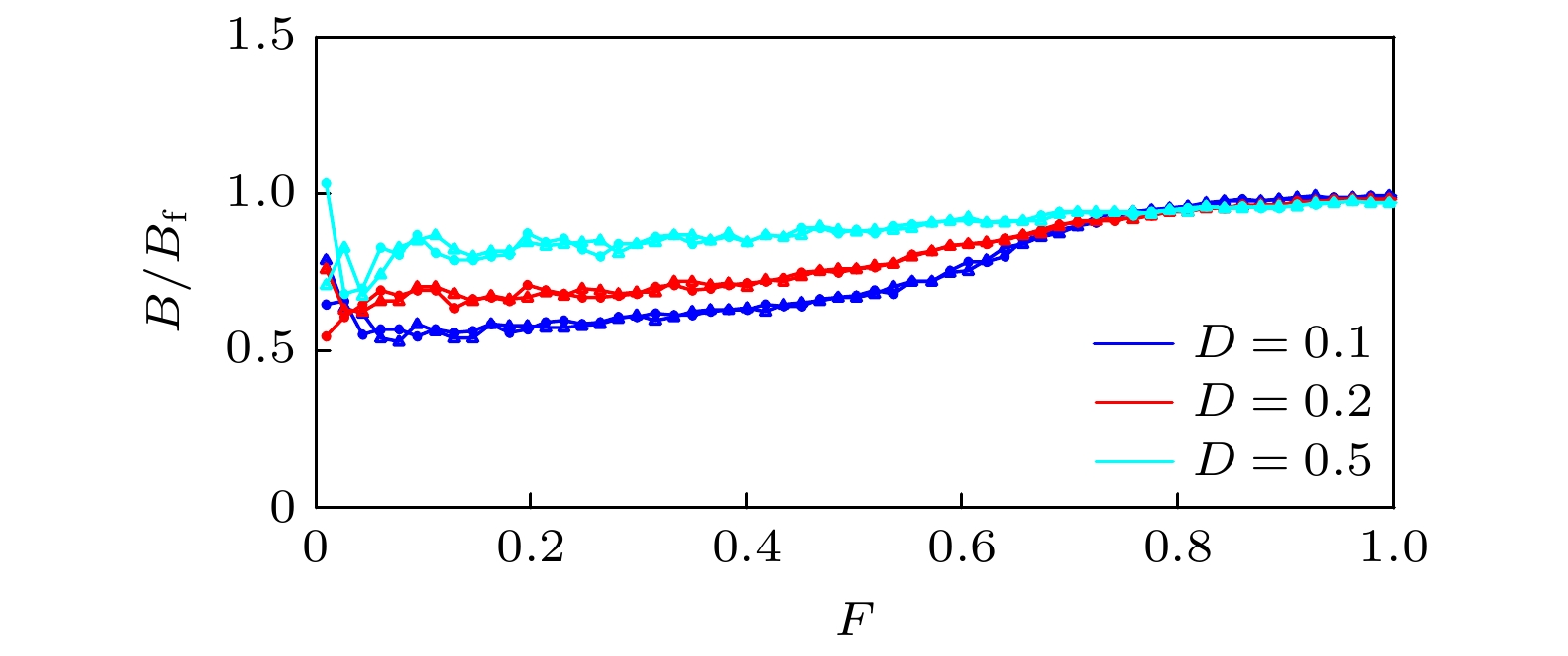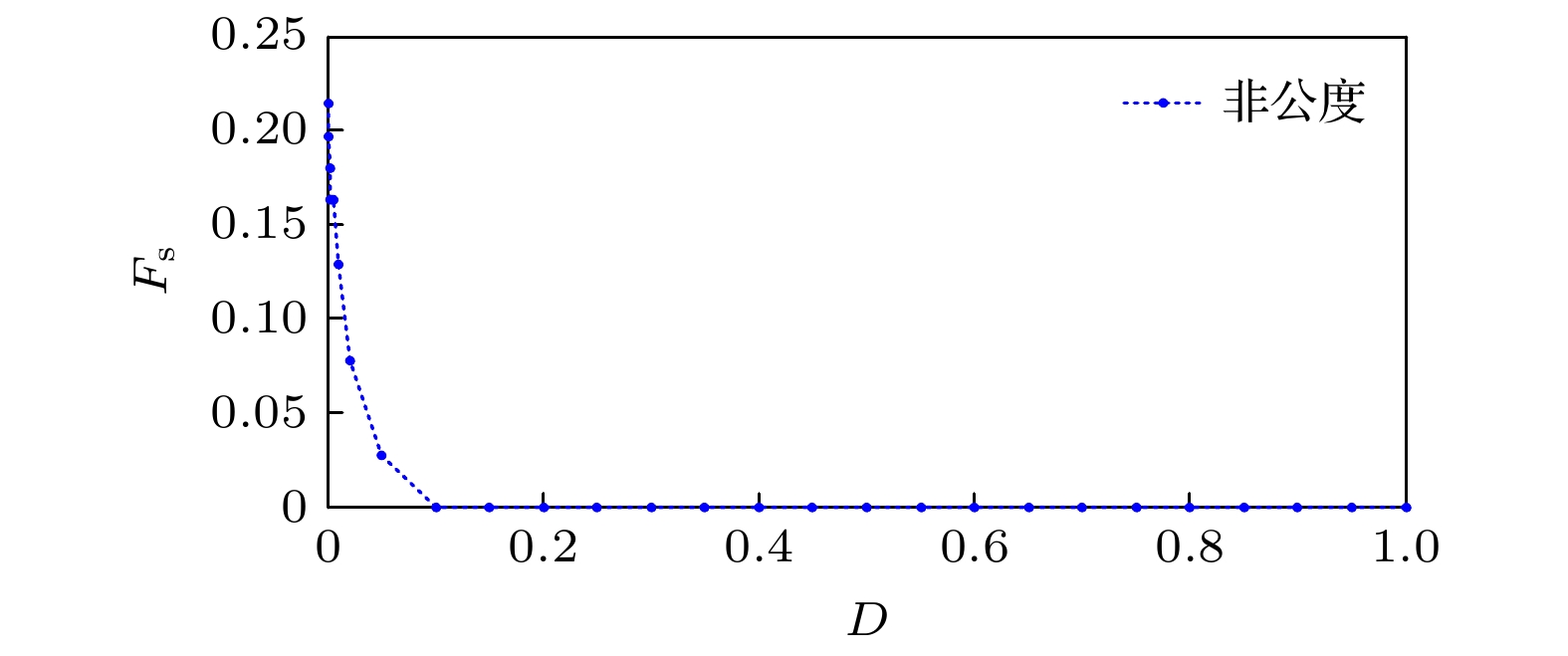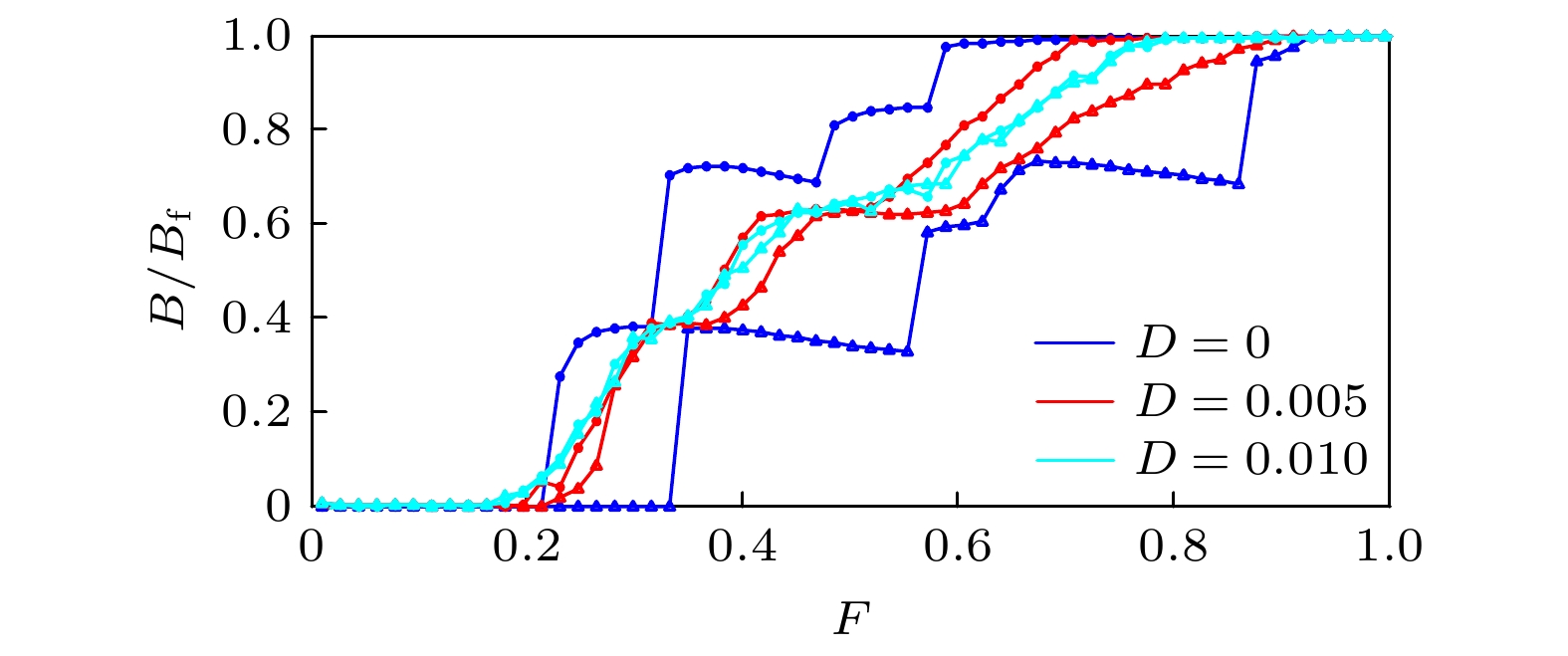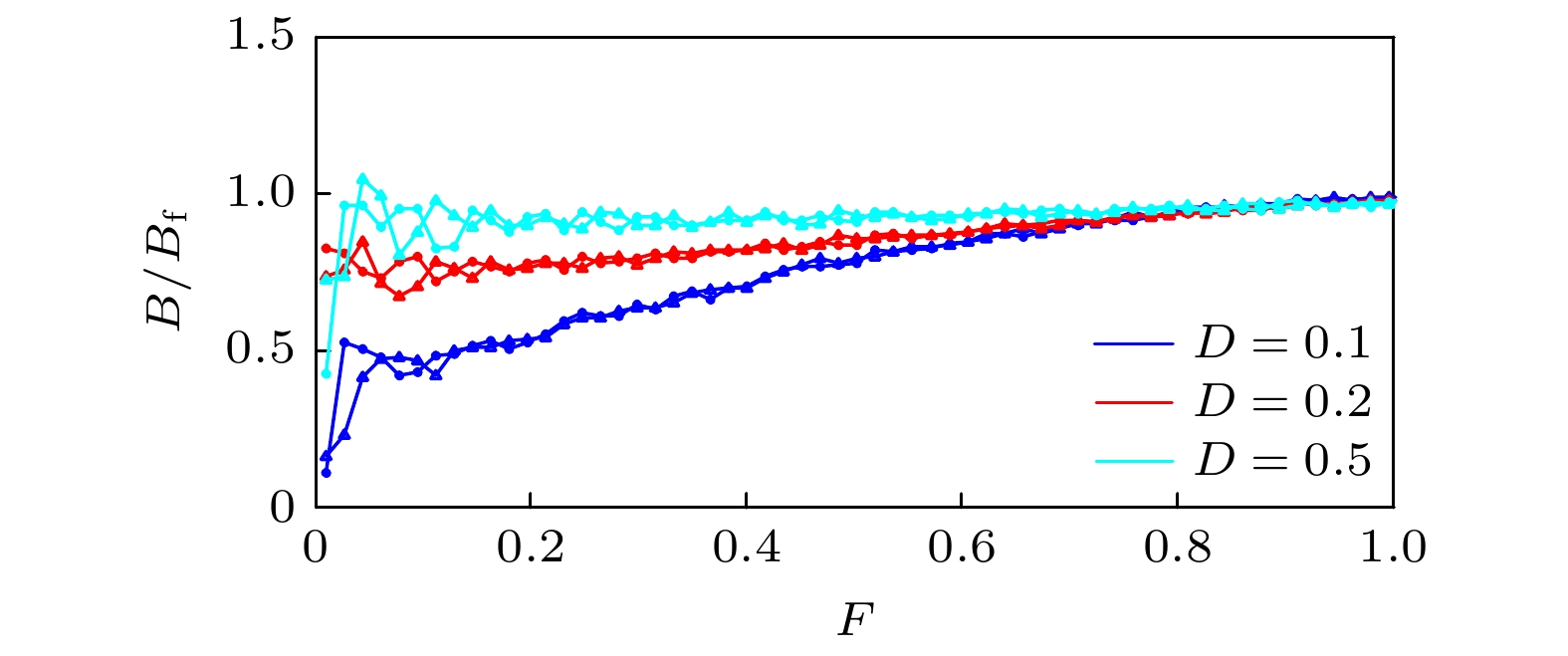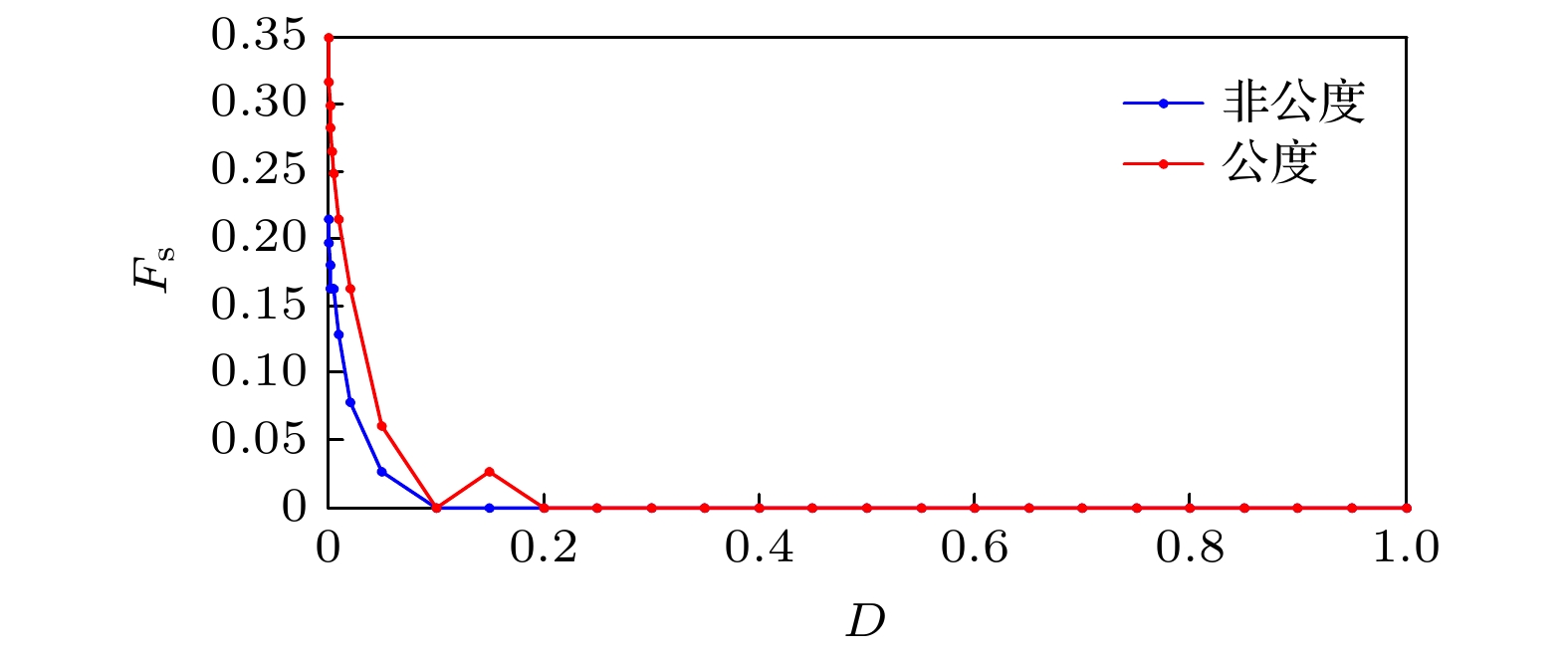-
基于一维Frenkel-Kontorova (FK)模型, 借助随机龙格库塔方法, 在非公度(incommensurate)和公度(commensurate)两种情形下, 分别研究了高斯白噪声激励下, 随机FK模型的纳米摩擦现象(滞回和超滑)随噪声强度的变化而变化的规律. 两种情形表明随着噪声强度的增大, 对减小系统滞回, 产生超滑有积极的影响. 另一方面, 当系统机动性能(chain mobility)未达到饱和状态(B = 1)时, 噪声的引入, 能加速原子的运动, 使得原子更易脱离基底势的束缚而做运动, 但是当系统达到饱和状态后, 系统机动性能并不受噪声的影响. 另外, 两种情形的区别是, 公度情形下, 由于原子受到基底势更强烈的耦合作用, 所以噪声对公度情形影响更为明显.
-
关键词:
- Frenkel-Kontorova模型 /
- 高斯白噪声 /
- 滞回 /
- 超滑
In this paper, the effects of a Gaussian white noise excitation on the one-dimensional Frenkel-Kontorova (FK) model are studied by the stochastic Runge-Kutta method under two different types of substrate cases, i.e. incommensurate case and commensurate case. The noise excitation is considered through the inclusion of a stochastic force via a Langevin molecular dynamics approach, and we uncover the mechanism of nano-friction phenomenon in the FK model driven by the stochastic force. The relationship between the noise intensity and the nano-friction phenomenon, such as hysteresis, maximum static friction force, and the super-lubricity, is investigated by using the stochastic Runge-Kutta algorithm. It is shown that with the increase of noise intensity, the area of the hysteresis becomes smaller and the maximum static friction force tends to decrease, which can promote the generation of super-lubricity. Similar results are obtained from the two cases, in which the ratios of the atomic distance to the period of the substrate potential field are incommensurate and commensurate, respectively. In particular, a suitable noise density gives rise to super-lubricity where the maximum static friction force vanishes. Hence, the noise excitation in this sense is beneficial to the decrease of the hysteresis and the maximum static friction force. Meanwhile, with the appropriate external driving force, the introduction of a noise excitation can accelerate the motion of the system, making the atoms escape from the substrate potential well more easily. But when the chain mobility reaches a saturation state (B = 1), it is no longer affected by the stochastic excitation. Furthermore, the difference between the two circumstances lies in the fact that for the commensurate interface, the influence of the noise is much stronger and more beneficial to triggering the motion of the FK model than for the incommensurate interface since the atoms in the former case are coupled and entrapped more strongly by the substrate potential.-
Keywords:
- Frenkel-Kontorova model /
- Gaussian white noise /
- hysteresis /
- super-lubricity
[1] 温诗铸 2007 机械工程学报 43 1
 Google Scholar
Google Scholar
Wen S Z 2007 Chin. J. Mech. Eng. 43 1
 Google Scholar
Google Scholar
[2] Braun O M, Kivshar Y S 2004 The Frenkel-Kontorova model: Concepts, Methods, and Applications (Berlin: Springer) pp2−20
[3] Wolfgang Q, Josep M B 2019 Eur. Phys. J. B 92 1
 Google Scholar
Google Scholar
[4] Lei Y M, Zheng F, Shao X Z 2017 Int. J. Bifurcation Chaos 27 1750052
 Google Scholar
Google Scholar
[5] Zhang Z J, Tang C M, Tong P Q 2016 Phys. Rev. E 93 022216
 Google Scholar
Google Scholar
[6] Vanossi A, Benassi A, Varini N, Tosatti E 2013 Phys. Rev. B 87 045412
 Google Scholar
Google Scholar
[7] Zhang J Q, Nie L R, Zhang X Y, Chen R Y 2014 Eur. Phys. J. B 87 1
 Google Scholar
Google Scholar
[8] 雷佑铭, 李毅伟, 赵云平 2014 物理学报 63 220502
 Google Scholar
Google Scholar
LeiY M, Li Y W, Zhao Y P 2014 Acta Phys. Sin. 63 220502
 Google Scholar
Google Scholar
[9] Yung K L, Lei Y M, Xu Y 2010 Chin. Phys. B 19 010503
 Google Scholar
Google Scholar
[10] 杨阳, 王苍龙, 段文山, 石玉仁, 陈建敏 2012 物理学报 61 130501
 Google Scholar
Google Scholar
Yang Y, Wang C L, Duan W S, Shi Y R, Chen J M 2012 Acta Phys. Sin. 61 130501
 Google Scholar
Google Scholar
[11] Yang Y, Duan W S, Yang L, Chen J M, Lin M M 2011 Europhys. Lett. 93 16001
 Google Scholar
Google Scholar
[12] Vanossi A, Santoro G, Bortolani V 2004 J. Phys. Condens. Matter 16 2895
 Google Scholar
Google Scholar
[13] Braun O M, Bishop A, Röder J 1997 Phys. Rev. Lett 79 3692
 Google Scholar
Google Scholar
[14] Vanossi A, Röder J, Bishop A, Bortolani V 2003 Phys. Rev. E 67 016605
 Google Scholar
Google Scholar
[15] Tekić J, Hu B 2008 Phys. Rev. B 78 104305
 Google Scholar
Google Scholar
[16] Tekić J, He D, Hu B 2009 Phys. Rev. E 79 036604
 Google Scholar
Google Scholar
[17] Tekić J, Hu B 2010 Phys. Rev. E 81 036604
 Google Scholar
Google Scholar
[18] Hu B, Tekić J 2007 Phys. Rev. E 75 056608
 Google Scholar
Google Scholar
[19] Capozza R, Vanossi A, Vezzani A, Zapperi S 2012 Tribol. Lett. 48 95
 Google Scholar
Google Scholar
[20] Braun O M, Zhang H, Hu B, Tekić J 2003 Phys. Rev. E 67 066602
 Google Scholar
Google Scholar
[21] Capozza R, Vanossi A, Vezzani A, Zapperi S 2009 Phys. Rev. Lett. 103 085502
 Google Scholar
Google Scholar
[22] Lin M M, Duan W S, Chen J M 2010 Chin. Phys. B 19 026201
 Google Scholar
Google Scholar
[23] Vanossi A, Braun O M 2007 J. Phys. Condens. Matter 19 305017
 Google Scholar
Google Scholar
[24] Guerra R, Vanossi A, Ferrario M 2007 Surf. Sci. 601 3676
 Google Scholar
Google Scholar
[25] Braun O M, Dauxois T, Paliy M V, Peyrard M 1997 Phys. Rev. E 55 3598
 Google Scholar
Google Scholar
[26] 李晓礼, 刘锋, 林麦麦, 陈建敏, 段文山 2010 物理学报 59 2589
 Google Scholar
Google Scholar
Li X L, Liu F, Lin M M, Chen J M, Duan W S 2010 Acta Phys. Sin. 59 2589
 Google Scholar
Google Scholar
[27] 秦文新 2017 中国科学: 数学 47 1853
 Google Scholar
Google Scholar
Qin W X 2017 Sci. Sin. Math. 47 1853
 Google Scholar
Google Scholar
[28] Honeycutt R 1992 Phys. Rev. A 45 600
 Google Scholar
Google Scholar
[29] 许爱国, 王光瑞, 陈式刚, 杨展如 1999 物理学进展 19 109
 Google Scholar
Google Scholar
Xu A G, Wang G R, Chen S G, Yang Z R 1999 Prog. Phys. 19 109
 Google Scholar
Google Scholar
-
图 1 D = 0, 0.005, 0.010时, 非公度情形下系统机动性能B随外力F的改变的变化规律(图中三角形和原点分别表示外力F绝热增加和减小的过程)
Fig. 1. Noise effects on static friction and hysteresis of the
$B(F)$ characteristics for the incommensurate case when D = 0, 0.005, 0.010. Triangles and circles denote, respectively, the adiabatic increasing and decreasing process of F.图 4 D = 0, 0.005, 0.010时, 公度情形下系统机动性能B随外力F的改变的变化规律(图中三角形和原点分别表示外力F绝热增加和减小的过程)
Fig. 4. Noise effects on static friction and hysteresis of the
$B(F)$ characteristics for the commensurate case when D = 0, 0.005, 0.010. Triangles and circles denote, respectively, the adiabatic increasing and decreasing process of F. -
[1] 温诗铸 2007 机械工程学报 43 1
 Google Scholar
Google Scholar
Wen S Z 2007 Chin. J. Mech. Eng. 43 1
 Google Scholar
Google Scholar
[2] Braun O M, Kivshar Y S 2004 The Frenkel-Kontorova model: Concepts, Methods, and Applications (Berlin: Springer) pp2−20
[3] Wolfgang Q, Josep M B 2019 Eur. Phys. J. B 92 1
 Google Scholar
Google Scholar
[4] Lei Y M, Zheng F, Shao X Z 2017 Int. J. Bifurcation Chaos 27 1750052
 Google Scholar
Google Scholar
[5] Zhang Z J, Tang C M, Tong P Q 2016 Phys. Rev. E 93 022216
 Google Scholar
Google Scholar
[6] Vanossi A, Benassi A, Varini N, Tosatti E 2013 Phys. Rev. B 87 045412
 Google Scholar
Google Scholar
[7] Zhang J Q, Nie L R, Zhang X Y, Chen R Y 2014 Eur. Phys. J. B 87 1
 Google Scholar
Google Scholar
[8] 雷佑铭, 李毅伟, 赵云平 2014 物理学报 63 220502
 Google Scholar
Google Scholar
LeiY M, Li Y W, Zhao Y P 2014 Acta Phys. Sin. 63 220502
 Google Scholar
Google Scholar
[9] Yung K L, Lei Y M, Xu Y 2010 Chin. Phys. B 19 010503
 Google Scholar
Google Scholar
[10] 杨阳, 王苍龙, 段文山, 石玉仁, 陈建敏 2012 物理学报 61 130501
 Google Scholar
Google Scholar
Yang Y, Wang C L, Duan W S, Shi Y R, Chen J M 2012 Acta Phys. Sin. 61 130501
 Google Scholar
Google Scholar
[11] Yang Y, Duan W S, Yang L, Chen J M, Lin M M 2011 Europhys. Lett. 93 16001
 Google Scholar
Google Scholar
[12] Vanossi A, Santoro G, Bortolani V 2004 J. Phys. Condens. Matter 16 2895
 Google Scholar
Google Scholar
[13] Braun O M, Bishop A, Röder J 1997 Phys. Rev. Lett 79 3692
 Google Scholar
Google Scholar
[14] Vanossi A, Röder J, Bishop A, Bortolani V 2003 Phys. Rev. E 67 016605
 Google Scholar
Google Scholar
[15] Tekić J, Hu B 2008 Phys. Rev. B 78 104305
 Google Scholar
Google Scholar
[16] Tekić J, He D, Hu B 2009 Phys. Rev. E 79 036604
 Google Scholar
Google Scholar
[17] Tekić J, Hu B 2010 Phys. Rev. E 81 036604
 Google Scholar
Google Scholar
[18] Hu B, Tekić J 2007 Phys. Rev. E 75 056608
 Google Scholar
Google Scholar
[19] Capozza R, Vanossi A, Vezzani A, Zapperi S 2012 Tribol. Lett. 48 95
 Google Scholar
Google Scholar
[20] Braun O M, Zhang H, Hu B, Tekić J 2003 Phys. Rev. E 67 066602
 Google Scholar
Google Scholar
[21] Capozza R, Vanossi A, Vezzani A, Zapperi S 2009 Phys. Rev. Lett. 103 085502
 Google Scholar
Google Scholar
[22] Lin M M, Duan W S, Chen J M 2010 Chin. Phys. B 19 026201
 Google Scholar
Google Scholar
[23] Vanossi A, Braun O M 2007 J. Phys. Condens. Matter 19 305017
 Google Scholar
Google Scholar
[24] Guerra R, Vanossi A, Ferrario M 2007 Surf. Sci. 601 3676
 Google Scholar
Google Scholar
[25] Braun O M, Dauxois T, Paliy M V, Peyrard M 1997 Phys. Rev. E 55 3598
 Google Scholar
Google Scholar
[26] 李晓礼, 刘锋, 林麦麦, 陈建敏, 段文山 2010 物理学报 59 2589
 Google Scholar
Google Scholar
Li X L, Liu F, Lin M M, Chen J M, Duan W S 2010 Acta Phys. Sin. 59 2589
 Google Scholar
Google Scholar
[27] 秦文新 2017 中国科学: 数学 47 1853
 Google Scholar
Google Scholar
Qin W X 2017 Sci. Sin. Math. 47 1853
 Google Scholar
Google Scholar
[28] Honeycutt R 1992 Phys. Rev. A 45 600
 Google Scholar
Google Scholar
[29] 许爱国, 王光瑞, 陈式刚, 杨展如 1999 物理学进展 19 109
 Google Scholar
Google Scholar
Xu A G, Wang G R, Chen S G, Yang Z R 1999 Prog. Phys. 19 109
 Google Scholar
Google Scholar
计量
- 文章访问数: 7431
- PDF下载量: 89
- 被引次数: 0















 下载:
下载:
